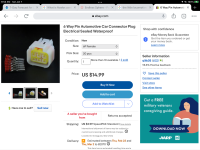DingusMcGee
10 kW
Electrical wires in operating ebikes corrode, but not all claims of satisfactory conducting agents lead to what will work well for the low and high DC voltage contacts of these machines.
Dielectric grease. Why not? It is non conducting.
[AC]Electricians use:

High DC voltages contacts can use some forms of anti-ox, but GB OX-Guard changes state with DC current and eventually or soon works quite poorly for conducting when DC contact interfaces are coated with it.
The FIX
Clean all contacts that have been coated with substances like GB Ox-Gard, Dielectric Grease, NoAlox and the likes. If the coating agents contain silicone, removing the compound may be difficult.

What agents are suitable for enhancing DC current flow?
I say carefully choose - - - -an Electrical Contact Grease product— Google will pull up non-conductors when queried by this word group. Our world of getting and giving CRAP.
A good electrical contact grease:

Or for an Amazon USA version see:
https://www.amazon.com/MG-Chemicals-Carbon-Conductive-Grease/dp/B005T8ROWA?th=1
These contact conduction enhancing greases are messy as they have a low viscosity, are very tenacious and so will smear easily. Conduction becomes everywhere there are connected smears — especially a problem for low voltage multiple wire connectors.
You have to be very discrete when applying these conducting greases to low voltage contacts like the Hall Wires. Any grease left on the plastic face surface of the female contact set can leads to a short circuit of these wires. Whereas such wiped thin coating on the Phase Wires will burn off these connections.
But it is false to think that a thin coat of GB Ox-Gard will burn off on phase wires.
Dielectric grease. Why not? It is non conducting.
[AC]Electricians use:

High DC voltages contacts can use some forms of anti-ox, but GB OX-Guard changes state with DC current and eventually or soon works quite poorly for conducting when DC contact interfaces are coated with it.
The FIX
Clean all contacts that have been coated with substances like GB Ox-Gard, Dielectric Grease, NoAlox and the likes. If the coating agents contain silicone, removing the compound may be difficult.

What agents are suitable for enhancing DC current flow?
I say carefully choose - - - -an Electrical Contact Grease product— Google will pull up non-conductors when queried by this word group. Our world of getting and giving CRAP.
A good electrical contact grease:

Or for an Amazon USA version see:
https://www.amazon.com/MG-Chemicals-Carbon-Conductive-Grease/dp/B005T8ROWA?th=1
These contact conduction enhancing greases are messy as they have a low viscosity, are very tenacious and so will smear easily. Conduction becomes everywhere there are connected smears — especially a problem for low voltage multiple wire connectors.
You have to be very discrete when applying these conducting greases to low voltage contacts like the Hall Wires. Any grease left on the plastic face surface of the female contact set can leads to a short circuit of these wires. Whereas such wiped thin coating on the Phase Wires will burn off these connections.
But it is false to think that a thin coat of GB Ox-Gard will burn off on phase wires.


